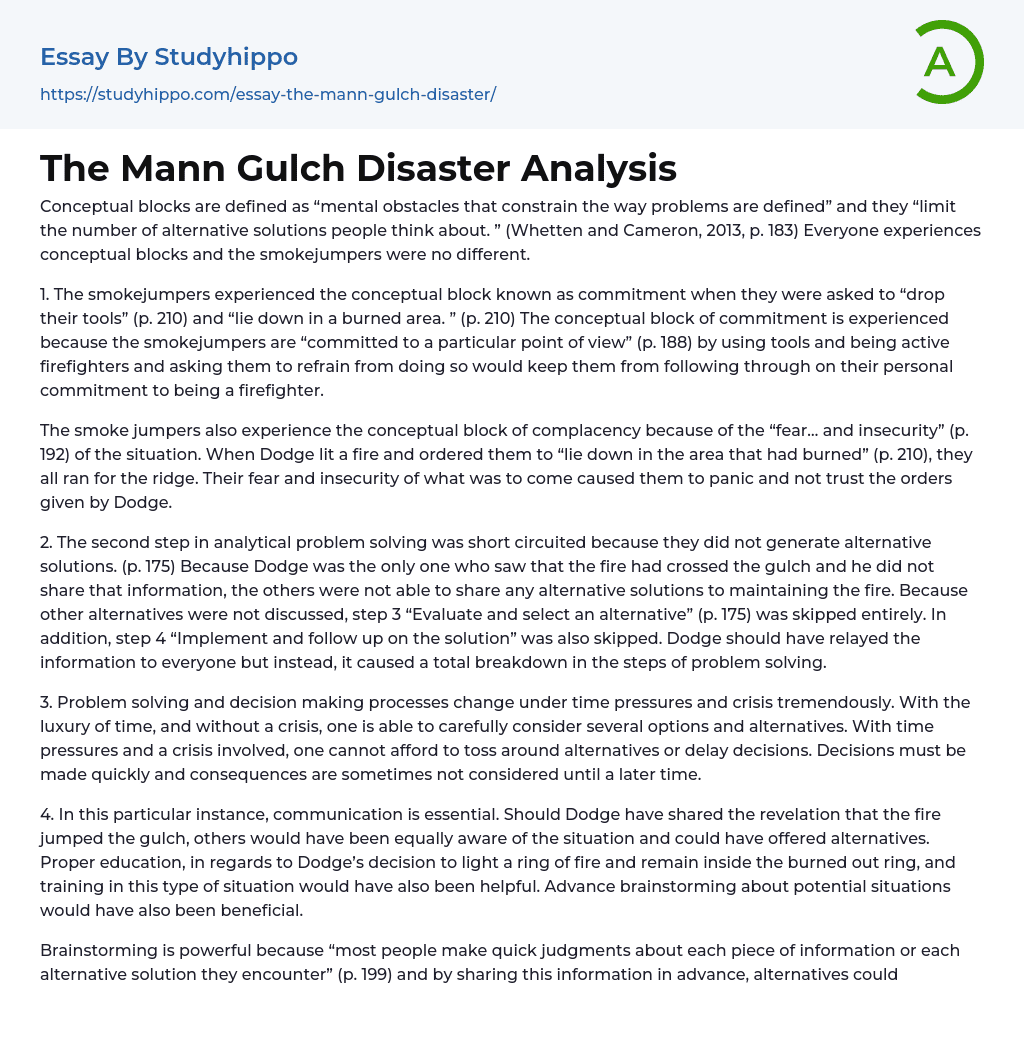Conceptual blocks are defined as “mental obstacles that constrain the way problems are defined” and they “limit the number of alternative solutions people think about. ” (Whetten and Cameron, 2013, p. 183) Everyone experiences conceptual blocks and the smokejumpers were no different.
1. The smokejumpers experienced the conceptual block known as commitment when they were asked to “drop their tools” (p. 210) and “lie down in a burned area. ” (p. 210) The conceptual block of commitment is experienced because the smokejumpers are “committed to a particular point of view” (p. 188) by using tools and being active firefighters and asking them to refrain from doing so would keep them from following through on their personal commitment to being a firefighter.
The smoke jump
...ers also experience the conceptual block of complacency because of the “fear… and insecurity” (p. 192) of the situation. When Dodge lit a fire and ordered them to “lie down in the area that had burned” (p. 210), they all ran for the ridge. Their fear and insecurity of what was to come caused them to panic and not trust the orders given by Dodge.
2. The second step in analytical problem solving was short circuited because they did not generate alternative solutions. (p. 175) Because Dodge was the only one who saw that the fire had crossed the gulch and he did not share that information, the others were not able to share any alternative solutions to maintaining the fire. Because other alternatives were not discussed, step 3 “Evaluate and select an alternative” (p. 175) was skipped entirely. In addition, step 4 “Implement and follow up on
the solution” was also skipped. Dodge should have relayed the information to everyone but instead, it caused a total breakdown in the steps of problem solving.
3. Problem solving and decision making processes change under time pressures and crisis tremendously. With the luxury of time, and without a crisis, one is able to carefully consider several options and alternatives. With time pressures and a crisis involved, one cannot afford to toss around alternatives or delay decisions. Decisions must be made quickly and consequences are sometimes not considered until a later time.
4. In this particular instance, communication is essential. Should Dodge have shared the revelation that the fire jumped the gulch, others would have been equally aware of the situation and could have offered alternatives. Proper education, in regards to Dodge’s decision to light a ring of fire and remain inside the burned out ring, and training in this type of situation would have also been helpful. Advance brainstorming about potential situations would have also been beneficial.
Brainstorming is powerful because “most people make quick judgments about each piece of information or each alternative solution they encounter” (p. 199) and by sharing this information in advance, alternatives could have been devised. Packing an additional radio, in case one of them is faulty or destroyed as in this case, would have also been beneficial. One conceptual blockbuster could have been to get everyone involved in the decision making process regarding alternatives.
Dodge could have explained why he started the additional fire. By educating them on this rationale, it may have saved lives instead of perpetuating a panic because others were not aware of
the logic behind this decision. Also, the crew expected a 10:00 fire and grew uneasy when it did not resemble one. More research on the current situation could have been performed so that the members would have been properly informed and realized that this was not a 10:00 fire and the situation could have been handled differently.
5. In this situation one should learn to think ahead and be prepared for worst case scenarios. Alternatives should have been discussed in a roleplaying atmosphere as practice so that proper understanding and education could have been exercised. By thinking ahead of situations, one is possibly thinking above the competition and discovering new ideas before the competition. In thinking ahead, one is also discovering solutions to combat the competition which could set them apart and distinguish them in a brighter light.
- Child essays
- Childcare essays
- Child labor essays
- Doll essays
- Incentive essays
- Academia essays
- Higher Education essays
- Language Learning essays
- Studying Business essays
- Education System essays
- Study essays
- First Day of School essays
- Scholarship essays
- Pedagogy essays
- Curriculum essays
- Coursework essays
- Studying Abroad essays
- Philosophy of Education essays
- Purpose of Education essays
- Brainstorming essays
- Educational Goals essays
- Importance Of College Education essays
- Brown V Board of Education essays
- The Importance Of Higher Education essays
- Online Education Vs Traditional Education essays
- Academic And Career Goals essays
- Academic Integrity essays
- Brown Vs Board Of Education essays
- Distance learning essays
- Technology in Education essays
- Vocabulary essays
- Writing Experience essays
- Importance of Education essays
- Early Childhood Education essays
- Academic Degree essays
- Academic Dishonesty essays
- School Uniform essays
- Academic writing essays
- Cheating essays
- Bachelor's Degree essays
- MBA essays
- College Life essays
- Grade essays
- Diploma essays
- Phonology essays
- Sentence essays
- Filipino Language essays
- Pragmatics essays
- Millennium Development Goals essays
- History Of Education essays




